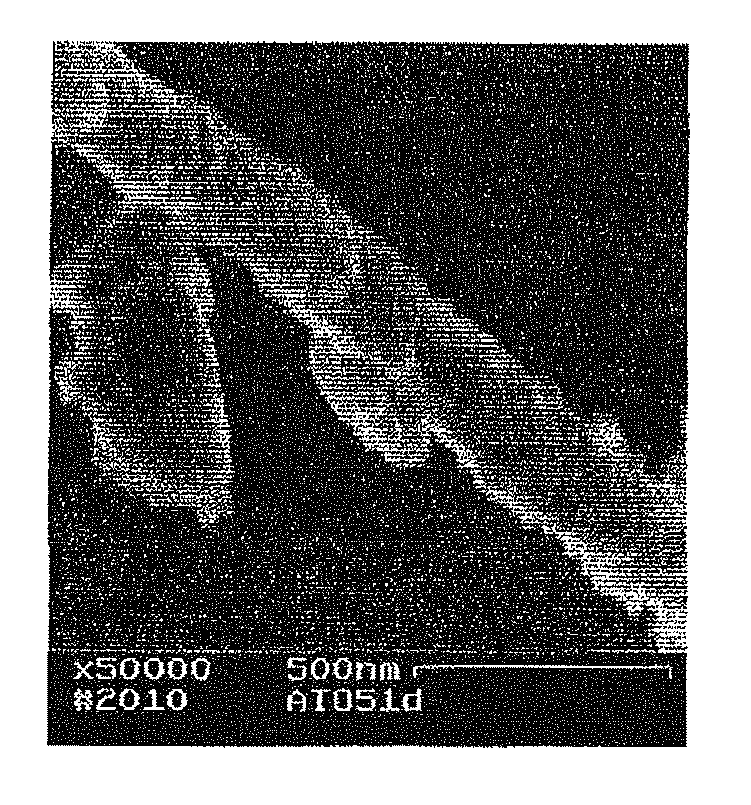Nanocomposites, method for producing same, and use thereof in devices for protecting against electromagnetic waves
a technology of nanocomposites and organic pigments, applied in the field of nanocomposites, can solve the problems of system based on organic pigments, wavelength-selective, and inability to limit in the infrared rang
- Summary
- Abstract
- Description
- Claims
- Application Information
AI Technical Summary
Benefits of technology
Problems solved by technology
Method used
Image
Examples
example 1
on of a Nanocomposite According to the Invention Formed from Carbon Nanotubes Covered and Filled with Niobium Pentoxide
[0082]A nanocomposite according to the invention based on commercial powders of multi-leaflet carbon nanotubes (CNTs) and niobium pentoxide (Nb2O5 / CNT powders) is prepared via the sol-gel route.
[0083]The sol-gel method used in the context of the present invention is based on the hydrolysis and condensation of niobium alkoxides or chlorides in an alcoholic solution in acidic medium. This method, known as “mild chemistry” (on account of the absence of use of pollutant solvents and of harsh experimental conditions), makes it possible to obtain solid particles of nanometric size.
Depilling / Deaggregation of the Bundles of CNT tubes
[0084]20 ml of absolute ethanol are mixed with 20 ml of acetic acid (these products are used without additional purification). The carbon nanotubes are added to the mixture and ultrasonicated for one hour so as to depell the bundles of carbon na...
example 2
ization of the Nanocomposite of Example 1, in Terms of Morphology and Particle Size
Characterization of the Morphology and Structure by TEM
[0092]An image of the structure and morphology of the nanocomposite of Example 1 was obtained by high-resolution transmission electron microscopy (TEM).
[0093]This image presented in FIG. 3 shows that the nanocomposite of Example 1 is formed from carbon nanotubes filled and / or covered with niobium pentoxide.
Characterization of the Size of the Grains by Laser Granulometry
[0094]The nanocomposite of Example 1 is suspended in chloroform at a rate of 2 g / l. The change as a function of time of the mean size of the particles or aggregates of the nanocomposite of Example 1 suspended in chloroform is then recorded by laser granulometry.
[0095]In parallel, the change as a function of time of the mean size of the carbon nanotubes suspended in chloroform (also at a rate of 0.2 g / l) after ultrasonication is also recorded.
[0096]The nanoparticle concentration of e...
example 3
the non-linear behaviour of the nanocomposite of Example 1 (via the Z-SCAN method)
[0099]For this study, the non-linear behaviour of the nanocomposite of Example 1 suspended in chloroform, that of chloroform (solvent) and that of CNTs suspended in chloroform were studied via the Z-scan technique. The concentrations are identical to those used in the particle size measurements.
[0100]The results are presented in FIG. 10, which shows that the energy arriving on the detector (placed just behind the sample) is reduced by more than 60% with the suspension of nanocomposite of Example 1 or of CNTs, when compared with the energy arriving on the detector in the case of a sample containing only chloroform.
[0101]The appearance (FIG. 9) and stability of the suspension of nanocomposite of Example 1 (FIG. 8) are such that they allow it to be used as an optical limiter, in contrast with carbon nanotubes, the latter being of lower stability in suspension.
PUM
| Property | Measurement | Unit |
|---|---|---|
| temperature | aaaaa | aaaaa |
| temperature | aaaaa | aaaaa |
| temperature | aaaaa | aaaaa |
Abstract
Description
Claims
Application Information
 Login to View More
Login to View More - R&D
- Intellectual Property
- Life Sciences
- Materials
- Tech Scout
- Unparalleled Data Quality
- Higher Quality Content
- 60% Fewer Hallucinations
Browse by: Latest US Patents, China's latest patents, Technical Efficacy Thesaurus, Application Domain, Technology Topic, Popular Technical Reports.
© 2025 PatSnap. All rights reserved.Legal|Privacy policy|Modern Slavery Act Transparency Statement|Sitemap|About US| Contact US: help@patsnap.com



